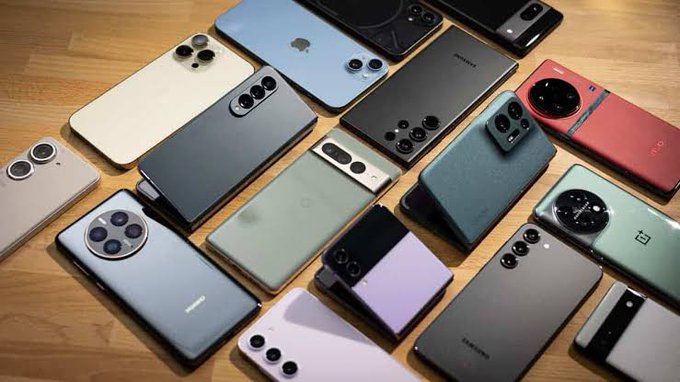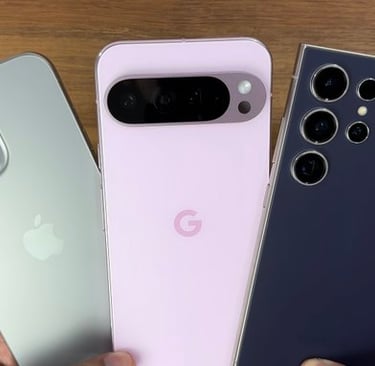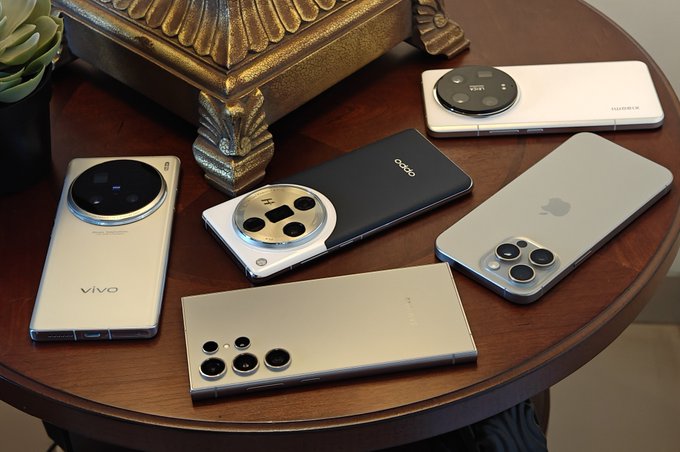The Competition Among Brands for the Best Camera Technology
Explore the intense competition among smartphone brands like Apple, Samsung, Google, and Xiaomi for the best camera technology. Learn about megapixel myths, sensor advancements, AI photography, zoom innovations (periscope lens), and what it all means for your next phone's camera.
GADGETS
Hafsa
4/1/20254 min read


In today's hyper-visual world, the smartphone camera has become a vital brand battleground. The competition for the "best" camera technology has evolved beyond megapixels to include everything from cutting-edge lens innovations to complex software algorithms and creative sensor designs. Taking beautiful photos is not the only goal here; you also need to create content, preserve memories, and eventually pick your next smartphone. The competition for supremacy in mobile photography is more intense than ever, as evidenced by the recent releases of gadgets like the Xiaomi 15 Ultra, Google Pixel 9 Pro, Samsung Galaxy S25 Ultra, and iPhone 16 Pro Max.
Smartphone Camera Development: From VGA to Virtual DSLRs
The development of smartphone cameras is an amazing story of technological advancement. Rudimentary VGA (Video Graphics Array) cameras were a feature of early mobile phones; they could capture images with little resolution and no sophisticated features. Manufacturers gradually concentrated on improving image quality over time. This required utilizing AI for intelligent image processing, introducing optical zoom for closer shots without digital degradation, implementing adaptable multi-lens setups, and integrating larger sensors to capture more light.
These days, flagship smartphones have advanced to the point where they can now compete with professional-grade cameras in many ways. They have features like advanced astrophotography modes to record the night sky, high-resolution 4K and even 8K video, and AI-powered editing tools that make complicated adjustments easier. Millions of people now have access to powerful creative tools, thanks to this evolution, which has democratized photography.


The Competition of Smartphone Brands in Camera Technology
There are multiple important areas where the competition for the best smartphone camera is evident:
The Megapixel Race: Beyond Just Quantities
Although a high megapixel count frequently makes news, it is important to realize that it is just one aspect of the picture. Larger print sizes and more detail can be achieved with more megapixels, but overall image quality is also influenced by sensor size and software processing, if not more so.
Example: With its enormous 200MP sensor, the Samsung Galaxy S25 Ultra can take incredibly detailed pictures with a lot of cropping options. On the other hand, the iPhone Despite using a 48MP sensor, the 16 Pro Max uses its advanced computational photography algorithms to produce images with exceptional dynamic range and remarkably natural color reproduction. This demonstrates the compromises between intelligent software optimization and raw resolution.
Larger Sensors for Improved Photography in Low Light
A larger sensor's surface area allows it to capture more light. This basic benefit directly translates into better performance in low-light conditions, producing images with more detail and brightness and less noise. Widely used in flagship devices, Sony's IMX series of sensors are well known for their ability to produce excellent image quality, especially in difficult lighting situations.
Example: The Xiaomi 15 Ultra is distinguished by its remarkable 1-inch sensor, which is a size usually associated with specialized compact cameras. It is a strong candidate for taking beautiful low-light photos with remarkable clarity and little grain because of its larger sensor, which enables it to capture noticeably more light.


Periscope Zoom: Getting Closer to Faraway Things
The introduction of periscope lenses has significantly changed the zoom capabilities of smartphones. Longer optical zoom ranges are made possible by these creative designs while maintaining a smartphone's thin profile. Brands can achieve impressive digital zoom capabilities (sometimes up to 100x) and optical zoom of up to 5x, 10x, or even more by using a prism to reflect light down the length of the phone without significantly sacrificing image quality.
Example: The Samsung Galaxy S25 Ultra, for instance, has a sophisticated periscope system with a 5x optical zoom and a 100x digital zoom. Whether it is zooming in on details at a concert or photographing wildlife from a safe distance, this enables users to capture distant subjects with remarkable clarity.
AI-Powered Photography: More Intelligent Image Handling
The use of artificial intelligence (AI) in contemporary smartphone cameras has become essential. Behind the scenes, AI algorithms put in endless effort to analyze scenes, improve colors, maximize focus, automatically modify camera settings for optimal results, and even carry out intricate tasks like detail enhancement and noise reduction.
Example: The AI-powered Night Sight feature of the Google Pixel 9 Pro is well-known. Even in almost complete darkness, this technology uses machine learning and computational photography to produce remarkably detailed and sharp low-light photos, frequently without the use of a flash.


Ultra-Wide & Macro Lenses: Photographic Versatility
A single lens is no longer the only option for modern smartphone camera systems. The addition of macro and ultra-wide lenses gives users more creative freedom. Large-scale scenes can be captured with ultra-wide lenses, making them ideal for architecture, landscapes, and group portraits. Contrarily, macro lenses allow users to take incredibly close-up pictures of tiny objects, displaying minute details that are not visible through a regular lens.
Example: The iPhone 16 Pro Max is more adaptable for capturing a wider perspective in a variety of situations, thanks to its improved ultrawide lens with enhanced edge correction to reduce distortion at the frame's edges and improve low-light performance.
Expert-Level Video Recording
Significant improvements have also been made to smartphones' video recording capabilities. These days, brands are concentrating on providing cinematic video recording capabilities, improved optical and electronic image stabilization to guarantee fluid footage, and artistic effects like real-time background blur (bokeh) for a more polished appearance.
Example: Professional filmmakers prefer the high-quality ProRes video format because of its editing flexibility, and the iPhone 16 Pro Max supports it. The Samsung Galaxy S25 Ultra, on the other hand, has AI stabilization to maintain even high-resolution footage steady and supports incredibly detailed 8K video recording.
Pro Mode & RAW Photography for Enthusiasts
Both amateur and professional photographers need to have manual control over camera settings. RAW photography gives users the most flexibility for post-production editing by enabling them to capture unprocessed image data. Camera apps' Pro Mode usually allows you to manually adjust settings like focus, shutter speed, ISO, and white balance.
Example: The Xiaomi 15 Ultra can capture a greater range of tonal information and offers DSLR-like control over the final appearance of the images during editing, thanks to its support for 10-bit RAW photos.
Insights
Explore the latest in tech and programming.
Contact
Blog
hello@neonbytes.online
© 2025. All rights reserved.
